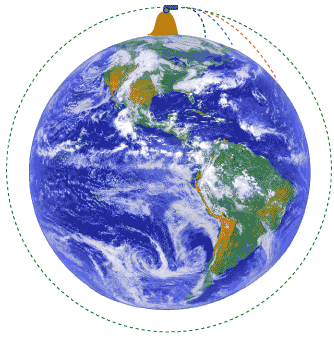
Finish Problems #1-4 for homework:


Finish Problems #1-4 for homework:

How do celestial bodies orbit each other? The moon orbits the Earth. The Earth orbits the sun. Our solar system is in orbit in the Milky Way galaxy… but how does it all work?

To explain orbits, Sir Isaac Newton developed a "thought experiment" in which he imagined a cannon placed on top of a very tall mountain, so tall, in fact, that the peak of the mountain was above the atmosphere (this is important because it allows us to neglect air resistance). If the cannon then launched a projectile horizontally, the projectile would follow a parabolic path to the surface of the Earth.
If the projectile was launched with a higher speed, however, it would travel farther across the surface of the Earth before reaching the ground. If its speed could be increased high enough, the projectile would fall at the same rate the Earth’s surface curves away. The projectile would continue falling forever as it circled the Earth! This circular motion describes an orbit.
Put another way, the astronauts in the Space Shuttle aren’t weightless. Far from it, actually, the Earth’s gravity is still acting on themand pulling them toward the center of the Earth with a substantial force. We can even calculate that force. If the Space Shuttle orbits the Earth at an altitude of 380,000m, what is the gravitational field strength due to the Earth?
Question: If the Space Shuttle orbits the Earth at an altitude of 380 km, what is the gravitational field strength due to the Earth?
Answer: Recall that we can obtain values for G, the mass of the Earth, and the radius of the Earth from the reference table.
This means that the acceleration due to gravity at the altitude the astronauts are orbiting the earth is only 11% less than on the surface of the Earth! In actuality, the Space Shuttle is falling, but it’s moving so fast horizontally that by the time it falls, the Earth has curved away underneath it so that the shuttle remains at the same distance from the center of the Earth — it is in orbit. Of course, this takes tremendous speeds… to maintain an orbit of 380 km, the space shuttle travels approximately 7680 m/s, more than 23 times the speed of sound at sea level!
Homework:
HW: Up & Down Problems
1. An object is thrown straight into the air. When it reaches its highest point, its velocity is ________________ and its acceleration is _____________________.
2. An object is thrown from the ground into the air with a speed of 20 m/s.
a. What is its speed when it hits the ground?
b. What is the object’s total time in the air?
c. What is the maximum height will the object reach?
3. Lebron James slam dunks a basketball and a physics student observes that Lebron’s feet are 1.0 meter above the floor at the peak of his jump. At what upward speed must Lebron leave the floor with to achieve this?
4. A cheerleader is thrown into the air. She is in the air for a total of 2.0 seconds.
a. With what initial velocity was the cheerleader thrown into the air?
b. What was her maximum height?
5. An arrow is shot straight up into the air with a velocity of 50 m/s.
a. What is the total time the arrow is in the air?
b. What is the maximum height above the ground that the arrow reaches?
The current model of sub-atomic structure used to understand matter is known as the Standard Model. Development of this model began in the late 1960s, and has continued through today with contributions from many scientists across the world. The Standard Model explains the interactions of the strong (nuclear), electromagnetic, and weak forces, but has yet to account for the gravitational force. The search for the theorized Higgs Boson at Fermilab and CERN is an attempt to better unify and strengthen the Standard Model.
Although the Standard Model itself is a very complicated theory, the basic structure of the model is fairly straightforward. According to the model, all matter is divided into two categories, known as hadrons and the much smaller leptons. All of the fundamental forces act on hadrons, which include
particles such as protons and neutrons. In contrast, the strong nuclear force doesn’t act on leptons, so only three fundamental forces act on leptons such as electrons, positrons, muons, tau particles and neutrinos.
Hadrons are further divided into baryons and mesons. Baryons such as protons and neutrons are composed of three smaller particles known as quarks. Charges of baryons are always whole numbers. Mesons are composed of a quark and an anti-quark (for example, an up quark and an antidown
quark). If this sounds like a lot to keep track of, have no fear, this is summarized for you on the Regents Physics Reference Table.
Scientists have identified six types of quarks. For each of the six types of quarks, there also exists a corresponding anti-quark with an opposite charge. The quarks have rather interesting names: up quark, down quark, charm quark, strange quark, top quark, and bottom quark. Charges on each quark are either one third of an elementary charge, or two thirds of an elementary charge, positive or negative, and the quarks are symbolized by the first letter of their name. For the associated anti-quark, the symbol is the first letter of the anti-quark’s name, with a line over the name. For example, the symbol for the up quark is u. The symbol for the anti-up quark is ū.
Similarly, scientists have identified six types of leptons: the electron, the muon, the tau particle, and the electron neutrino, muon neutrino, and tau neutrino. Again, for each of these leptons there also exists an associated anti-lepton. The most familiar lepton, the electron, has a charge of -1e. Its anti-particle, the positron, has a charge of +1e.